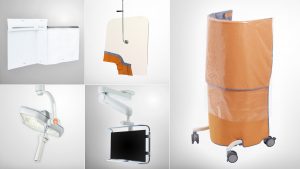Publications. Studies. Science.
MAVIG is a leading company in the field of medical technology and radiation protection. Our products are based on the latest technical and scientific research.
Learn more about the use of radiation in medicine and the state-of-the-art measures for radiation protection in the following publications.
X-ray protective clothing

New protection concept: optimized X-ray aprons could be 50 % lighter
H Eder · H Schlattl
This paper is a critical analysis of the current protection concept for X-ray protective clothing. The sense and nonsense of the material distribution of personal protective equipment are considered and a more differentiated evaluation including the organ-specific radiation sensitivity is demanded.
Eder H., Schlattl H. (2021): Neues Schutzkonzept: Optimierte Röntgenschürzen könnten 50 % leichter sein. Der Radiologe 61:386–388, doi: 10.1007/s00117-021-00809-3
Are X-ray safety glasses alone enough for adequate ocular protection in complex radiological interventions?
M Grau · O Eldergash · S Sunder Amin · T Kowald · J Schnabel · A Wißmann · S Simka · A Chavan · C Mathys · B Poppe · B Schmuck · R P Thomas
Wearing radiation protection goggles helps to comply with the annual limit of the eye lens dose. Unprotected and protected eye lens doses for interventionists are evaluated in this paper. The fact that wearing radiation protection goggles alone cannot guarantee compliance with the dose limits and what other measures provide a solution are discussed.
Grau M., Eldergash O., Sunder Amin S. et al. (2021): Are X-ray Safety Glasses Alone Enough for Adequate Ocular Protection in Complex Radiological Interventions? Health Physics 120(6):p 641-647, doi:10.1097/HP.0000000000001393
Use of effective dose to assess X-ray protective clothing
H Eder · H Schlattl
In this paper, the team of authors provides an overview of the results of various studies dealing with the improvement of the state-of-the-art personal protective equipment for clinical use of X-rays. Among other things, the latest findings are demonstrated by considering the 3D attenuation properties of X-ray protective clothing.
Eder H., Schlattl H. (2021): Use of effective dose to assess X-ray protective clothing. Journal of Radiological Protection 41 :140–151, doi: 10.1088/1361-6498/ac191a
Shielding effectiveness of X-ray protective garment
H Eder · H Schlattl
This publication deals with the difference in the shielding effect of X-ray protection comparing real-life use of personal protective equipment and the test conditions used for the certification of protective materials. The 3D effect of protective clothing while being worn provides interesting results.
Eder H., Schlattl H. (2021): Shielding effectiveness of X-ray protective garment. Physica Medica: European Journal of Medical Physics 82:343–350, doi: 10.1016/j.ejmp.2021.01.081
Tertiary X-radiation – A problem for staff protection?
H Eder · M Seidenbusch · LS Oechler
Subject of this study are tertiary X-ray radiation and the clarification of the question to what extent it contributes to the personal dose. Since the influence of tertiary X-ray radiation on radiological personnel is largely unknown, the measurements carried out in this study provide interesting information.
Eder H., Seidenbusch M., Oechler L. S. (2020): Tertiary X-Radiation – A Problem for Staff Protection? Radiation Protection Dosimetry 189(3): 304–311, doi:10.1093/rpd/ncaa043
Patient protection products in computed tomography – Protection from incorrect CT settings
M Liebmann · T Lüllau · B Poppe · H von Boetticher
The subject of this study by several professionally and scientifically renowned radiation physicists is the effectiveness of radiation protective measures for the thyroid, sternum and breast of patients undergoing cranial CT examinations.
Liebmann M., Lüllau T., Poppe B., von Boetticher H. (2013): Patientenschutzmittel in der Computertomographie – Schutz vor schlechten Einstellungen. DGMP 2013. 44. Jahrestagung der Deutschen Gesellschaft für Medizinische Physik, Köln, 18.-21.09.2013: 361-362, 753
System Solutions

A new design of a lead-acrylic shield for staff dose reduction in radial and femoral access coronary catheterization
H Eder · M C Seidenbusch · M Treitl · P Gilligan
This study evaluates a novel on-site protective device for cardiac catheterization and coronary interventions. By using an enlarged lead acrylic shield, combined with a lead lamella curtain and X-ray protective patient drapes, the radiation protection of the examiner in general and especially of the skull and eye lenses is improved.
Eder H., Seidenbusch M. C., Treitl M., Gilligan P. (2015): A New Design of a Lead-Acrylic Shield for Staff Dose Reduction in Radial and Femoral Access Coronary Catheterization. Röfo 2015 187(10): 915-923, doi:10.1055/s-0034-1399688
Staff dose evaluation by application of radiation protection during endoscopic retrograde cholangiopancreatography (ERCP) procedures performed with a mobile C-arm
A Österlund · W Drohn · H Hoedlmoser · M Greiter · M Schmid · H-E Källman
The aim of this study carried out by the team of authors from Sweden and Germany is the evaluation of a lower body radiation shield attached to the patient positioning table during ERCP procedures. The measurements performed demonstrate a significant shielding effect, especially to the lower body of the operator and the assistant.
Österlund A., Drohn W., Hoedlmoser H. et al. (2022): Staff dose evaluation by application of radiation protection during endoscopic retrograde cholangiopancreatography (ERCP) procedures performed with a mobile C-arm. Acta Radiologica. 2022; 63(1):11-21, doi: 10.1177/0284185120983281
Efficacy of MAVIG X-ray protective drapes in reducing CTO operator radiation
K McCutcheon · M Vanhaverbeke · J Dabin · R Pauwels · W Schoonjans · W Desmet · J Bennett
In this study, the authors from the Belgian University Hospital Leuven, the Catholic University of Leuven and the Belgian Center for Nuclear Research address the radiation exposure of the surgeon specifically in CTO-PCI, often carried out with double access, and the effect of radiation protection drapes to reduce the dose. The result of the study shows a significant reduction in radiation dose.
McCutcheon K., Vanhaverbeke M., Dabin J. et al. (2021): Efficacy of MAVIG X-Ray Protective Drapes in Reducing CTO Operator Radiation. Journal of Interventional Cardiology, vol. 2021, Article ID 3146104, doi: 10.1155/2021/3146104
Assessment of clinical occupational dose reduction effect of a new interventional cardiology shield for radial access combined with a scatter reducing drape
P Gilligan · J Lynch · H Eder · S Maguire · E Fox, B Doyle · I Casserly · H McCann · D Foley
The work of the international team of authors discusses the reduction of occupational dose during cardiac interventions with radial access. A novel radiation protective shield in combination with a radiation protective drape is used in this study. The use of these protective devices has been shown to be very beneficial in significantly reducing radiation exposure to the examiner.
Gilligan P., Lynch J., Eder H. et al. (2015): Assessment of Clinical Occupational Dose Reduction Effect of a New Interventional Cardiology Shield for Radial Access Combined With a Scatter Reducing Drape. Cathet. Cardiovasc. Interventions, 86: 935-940, doi: 10.1002/ccd.26009
Use of an adaptable protective drape in ERCP – phantom study
H Eder
The publication investigates the use of a two-part shielding drape for ERCP workstations. The result of the study on the phantom shows that the patient drape, which can be adapted to the patient’s field size, can reduce the radiation exposure of the examination personnel by up to 90%, especially in the area of the upper body and skull.
Eder H . (2019): Einsatz einer adaptierbaren Abschirmdecke bei ERCP – Studie am Phantom. radiologie|technologie, Volume 2/2019
Efficacy of MAVIG X-ray protective drapes in reducing operator radiation dose in the cardiac catheterization laboratory: A randomized controlled trial
K McCutcheon · M Vanhaverbeke · R Pauwels · J Dabin · W Schoonjans · J Bennett · T Adriaenssens · C Dubois · P Sinnaeve · W Desmet
The study by the Belgian University Hospital Leuven, the Catholic University of Leuven, and the Belgian Center for Nuclear Research concluded that the use of a femoral or radial radiation protective drape during cardiac catheterization and percutaneous coronary interventions is associated with a ≥ 50% reduction in operator radiation dose.
McCutcheon K., Vanhaverbeke M., Pauwels R. et al. (2020): Efficacy of MAVIG X-Ray Protective Drapes in Reducing Operator Radiation Dose in the Cardiac Catheterization Laboratory: A Randomized Controlled Trial. Circulation: Cardiovascular Interventions, Volume 13, Issue 11, doi: 10.1161/CIRCINTERVENTIONS.120.009627
Guidelines to establish and operate catheterization laboratories and hybrid operating rooms/hybrid laboratories
V Schächinger · H Nef · S Achenbach · C Butter · I Deisenhofer · L Eckardt · H Eggebrecht · E Kuon · B Levenson · A Linke · K Madlener · H Mudra · C K Naber · J Rieber · H Rittger · T Walther · T Zeus · M Kelm
The guideline sets a quality standard for the structural and organizational framework of cardiac catheterization laboratories and hybrid operating rooms. The required and recommended radiation protection equipment is also addressed in the guideline.
Schächinger V., Nef H., Achenbach S. et al. (2015): Leitlinie zum Einrichten und Betreiben von Herzkatheterlaboren und Hybridoperationssälen/Hybridlaboren. Kardiologe 2015(3):89–123, doi: 10.1007/s12181-014-0631-7















